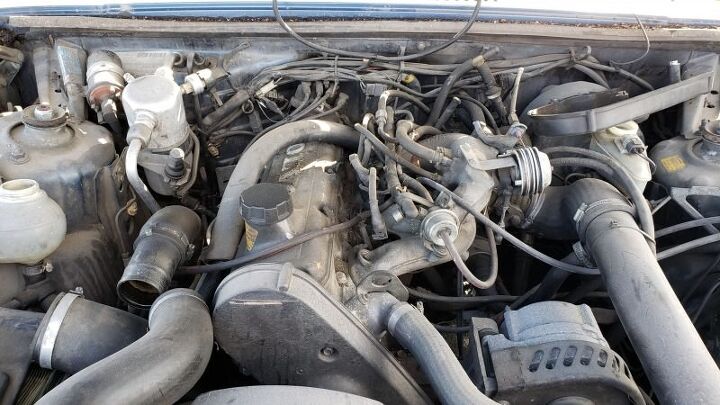Junkyard Find: 1990 Volvo 740 Turbo With Nearly 500,000 Miles

One of the frustrating things about my job looking for interesting discarded vehicles is the fact that most cars and light trucks didn’t start getting six-digit odometers until the 1980s or even the 1990s. I find vehicles that I know must have racked up incredible total mileage figures, but their odometers all turned over (once? ten times?) when they got past 99,999 miles.
Fortunately, Volvo felt sufficiently optimistic to adopt the six-digit odometer way back in the 1960s, so I was able to read a very impressive figure on the one in this 740 wagon: 493,549 miles.
Yes, that’s close to 16,500 miles every year for its three-decade lifespan. I’ve found a Mercedes-Benz W201 with better than 600,000 miles and a Volkswagen Rabbit Cabrio showing a not-sure-I-believe-it 930,013 miles, plus lots and lots of junked Hondas and Toyotas (and one Oldsmobile) with readings of close to 400,000 miles, but this Volvo in the San Francisco Bay Area ranks near the top of the longevity sweepstakes.
One thing I’ve found with extreme-high-mile junkyard cars is that most of them were in decent cosmetic shape when they finally wore out (or, more likely, were traded in and then proved radioactively unsaleable at auction). That makes sense, because the kind of vehicle owner who takes care of all the maintenance over multiple decades also takes good care of the body and interior. A nasty hooptie with a shredded interior tends to get thrown out when something mechanical costing more than a couple of hundred bucks fails. Looking at this car, I’d have guessed it had perhaps 150,000 miles, not three times that. I see this phenomenon often with high-mile junkyard (rear-wheel-drive) Volvos.
The turbocharged engine is a bit of a surprise, though, because cars with forced induction run hotter, blow head gaskets more readily, and generally get hooned on harder than their naturally-aspirated counterparts.
Perhaps the automatic transmission served to keep the drivers of this car from getting too lead-footed with that 162-horse turbo motor.
To a radar gun, it looked exactly like a Porsche 944… though I’ll bet the brick shape of the Volvo made it detectable at a longer range.
For links to 1,800+ more posts like this one, head to the Junkyard Home of the Murilee Martin Lifestyle Brand™.

Murilee Martin is the pen name of Phil Greden, a writer who has lived in Minnesota, California, Georgia and (now) Colorado. He has toiled at copywriting, technical writing, junkmail writing, fiction writing and now automotive writing. He has owned many terrible vehicles and some good ones. He spends a great deal of time in self-service junkyards. These days, he writes for publications including Autoweek, Autoblog, Hagerty, The Truth About Cars and Capital One.
More by Murilee Martin
Latest Car Reviews
Read moreLatest Product Reviews
Read moreRecent Comments
- Luke42 When will they release a Gladiator 4xe?I don’t care what color it is, but I do care about being able to plug it in.
- Bd2 As I have posited here numerous times; the Hyundai Pony Coupe of 1974 was the most influential sports and, later on, supercar template. This Toyota is a prime example of Hyundai's primal influence upon the design industry. Just look at the years, 1976 > 1974, so the numbers bear Hyundai out and this Toyota is the copy.
- MaintenanceCosts Two of my four cars currently have tires that have remaining tread life but 2017 date codes. Time for a tire-stravaganza pretty soon.
- Lorenzo I'd actually buy another Ford, if they'd bring back the butternut-squash color. Well, they actually called it sea foam green, but some cars had more green than others, and my 1968 Mercury Montego MX was one of the more-yellow, less-green models. The police always wrote 'yellow' on the ticket.
- ToolGuy Some of my first cars were die-cast from pot-metal in 2 pieces: body-in-white plus chassis. I spray-painted some of them, the masking was a pain. The tires did burn realistically.













































Comments
Join the conversation
These went from essentially everywhere in the early 2010s to non existent in the late 2010s
The overall shape of this vehicle appeals to me very much. Minor issues: - The tailpipe is way wrong. - The clock does not deserve equal billing with the speedometer and tachometer. [This vehicle burned something like $50,000 worth of gasoline over its lifetime.]